Excerpts from Jim Conrad's
Naturalist Newsletter
Entry dated December 28, 2023, issued from near Tequisquiapan; elevation about 1,900m, (6200 ft), ~N20.57°, ~W99.89°; Querétaro state, MÉXICO
BABY JUMP-UP
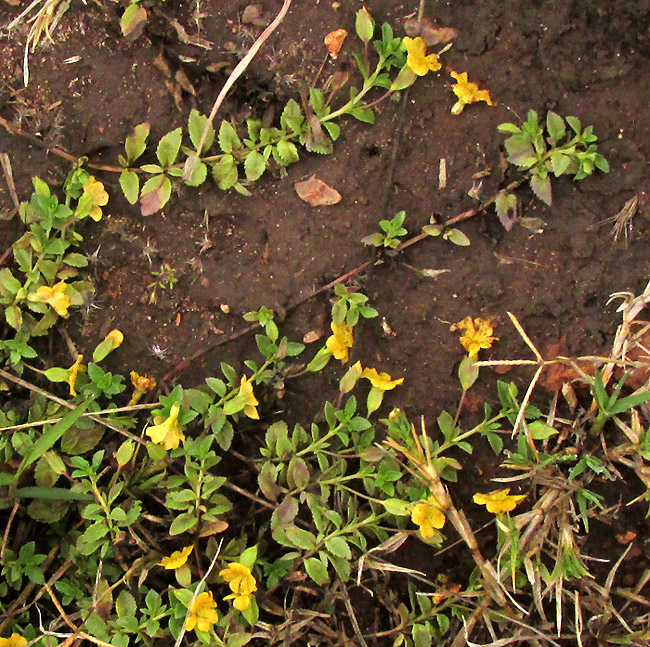
In a grossly sheep-overgrazed, abandoned field and during a continuing two-year drought described by the online North American Drought Monitor as a D3 Extreme Drought, after a rainy season that simply didn't develop, there only remained sparse grass and herbs, all parched gray and brown. Except, that is, for a single flat patch of a creeping, yellow-flowered herb, a part of which is shown above. The whole patch was about 60cm across (2ft). Years ago they'd tried to grow corn here, and our plant was rooted in the bottom of a very shallow furrow between earlier cornrows; that helped the herb with its water, but not much. The soil was hard compacted, so most rainfall immediately drained downslope.
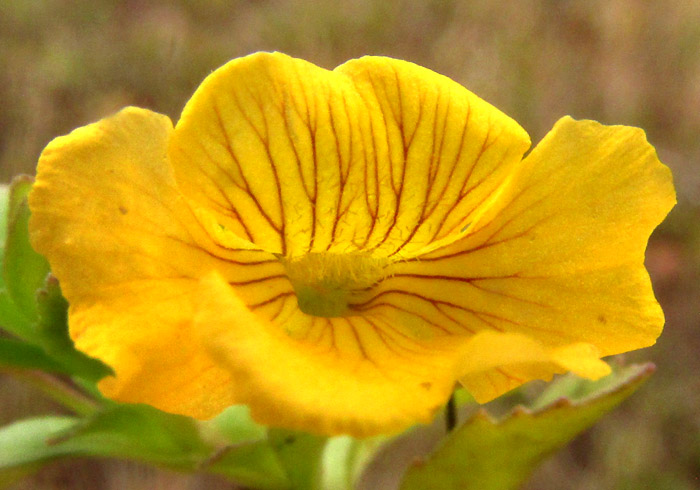
With the plant's many stems creeping across the ground and the yellow flowers' strongly bilateral symmetry, and the corollas' openings having hairy "beards" on one side, the whole plant strongly suggested a species of monkeyflower, of the genus Erythranthe. For example, you can compare our plant to the Round-leaf Monkeyflower often seen in wet environments throughout much of Mexico and Central America.
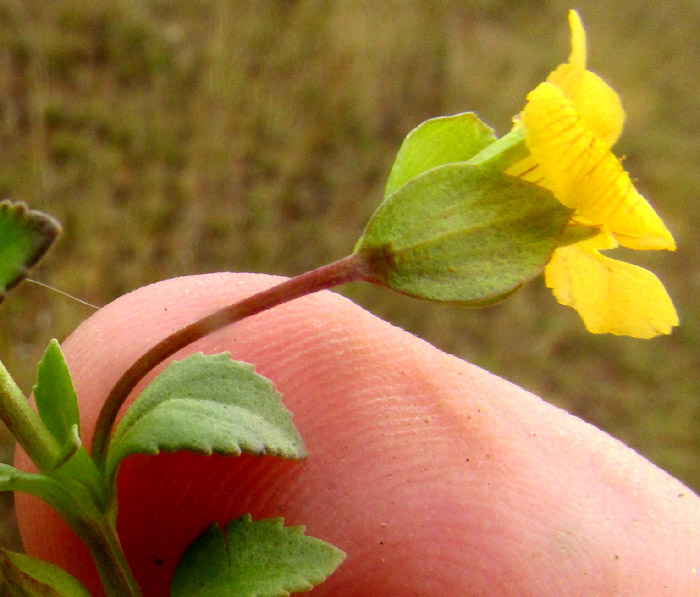
However, the above side view of the flower shows a pair of well developed, oval, leaf-like bracteoles almost hiding the green calyx's five slender lobes. Monkeyflowers don't produce bracteoles; their calyxes are clearly visible.
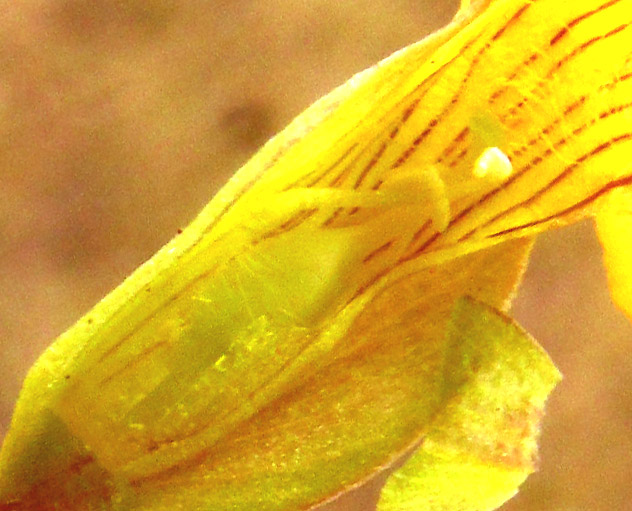
Removing one side of the corolla, as seen above, revealed two of the flower's four stamens. Their filaments were attached to the corolla tube's wall and leaned toward the greenish ovary's slender style, which was topped by a whitish, two-lobed stigma. Despite producing such large bracteoles, the flower's interior is like those in monkeyflower blossoms. Here's what our plant's entire population looked like:
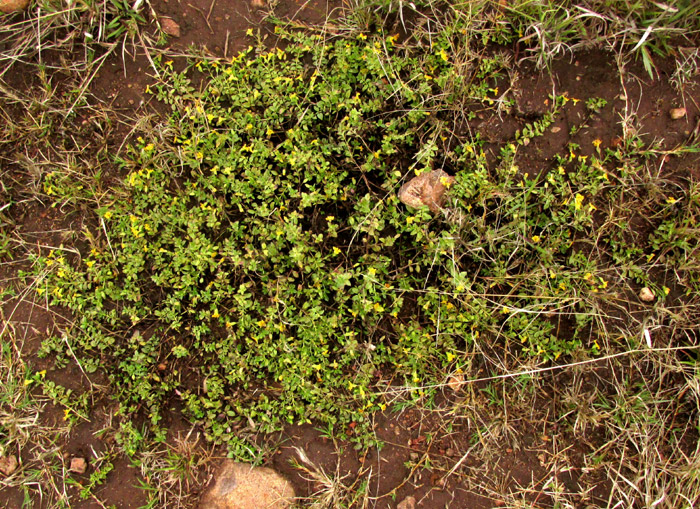
Our plant's close similarity to monkeyflowers caused identification problems. It turns out that the monkeyflower genus Erythranthe currently is assigned to the Lopseed Family, the Phrymaceae, while our plant currently belongs to the Plantain Family, the Plantaginaceae; they're in different families. Both monkeyflowers and our plant earlier were members of the Snapdragon Family, the Scrophulariaceae, but once again modern genetic studies indicate otherwise, the plants' similarity apparently a consequence of convergent evolution.
If you can overcome the problem of recognizing that our plant belongs to the Plantain Family, identification becomes easy. Simply by producing yellow, strongly bilaterally symmetrical corollas bearing four fertile stamens, no sterile staminode, and not producing a spur, and by pairs of leaves appearing at stem nodes, not just one leaf, our plant reveals itself as the genus Mecardonia. In our part of the central Mexican highlands known as the Bajío, the only documented member of that genus is MECARDONIA PROCUMBENS. Our plant's English name, regrettable for such a hardscrabble species capable of being the only flowering plant in a large field devastated by overgrazing and drought, somehow has become generally accepted as Baby Jump-up.
Mecardonia procumbens occurs generally throughout the tropical and subtropical Americas, plus it's become invasive elsewhere, especially in southern Asia to northern Australia, plus Africa. The Flora del Bajío describes our plant's preferred habitats as forests of oak and pine, tropical scrub, arid grasslands and adjacent pastures, especially in waterlogged soils -- sitios encharcados -- while the Flora of North America describes wetlands, stream edges, springs and seeps, deserts in upland washes, and canyons with moisture. Seeing how Baby Jump-up thrives in our ravaged, parched field, I'd say that the species is poised to expand into even more of the Earth's spoiled lands.
The online Atlas de las Plantas de la Medicina Tradicional Mexicana, which calls our plant hierba de la golondrina, or "Swallow plant," and still uses outdated taxonomy, mentions that Mecardonia procumbens has been used in Mexican traditional medicine. It's been employed to deal with fatigue, anemia, malaria and gallbladder problems, to reduce fever, treat eye diseases, and to remove stains from the face. Very few studies have been undertaken with regard to the plant's healing power, but the 2010 Master's thesis of Oriana Hidalgo Alegría entitled "Determinación del efecto cicatrizante del extracto acuoetanolico de la planta Bacopa Procumbens en la línea celular 3t3 de fibroblastos de ratón," found that an extract from our plant showed effects on rat tissue suggesting that it might promote healing.